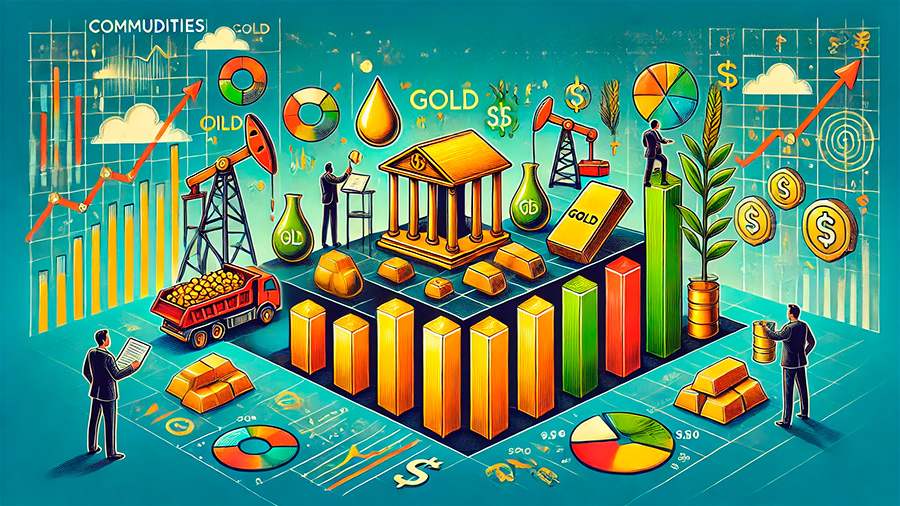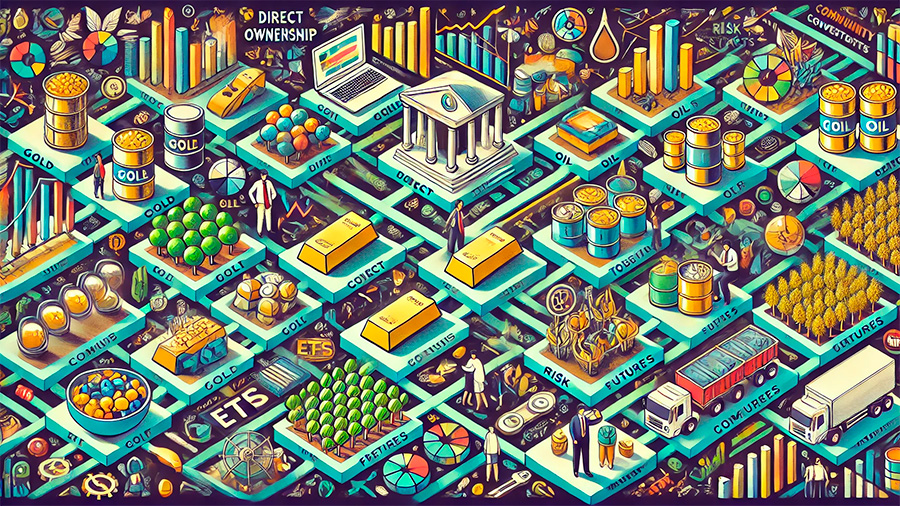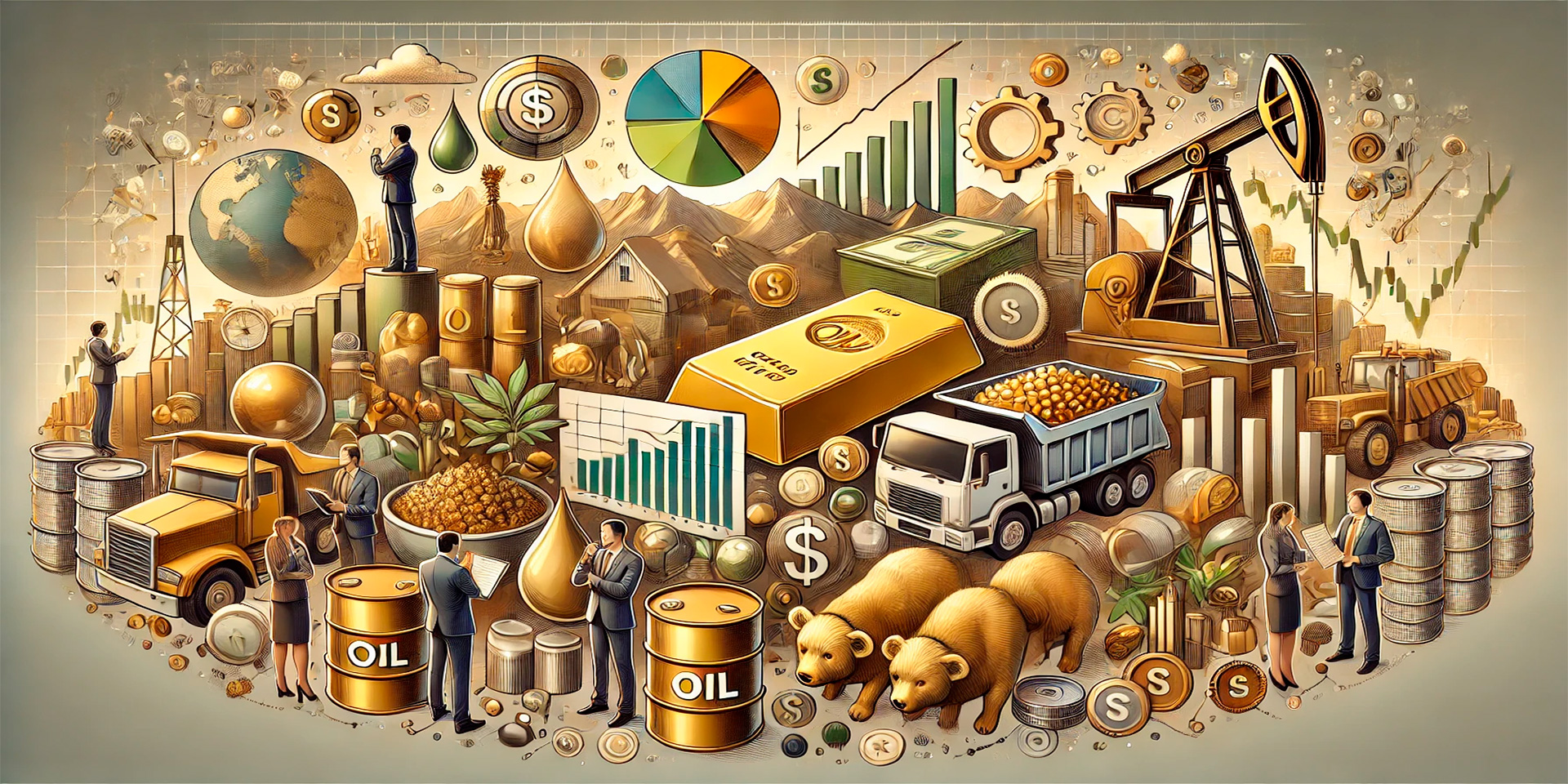The Benefits of Investing in Commodities: A Guide to Diversification and Wealth Protection
Commodities play a unique and important role in a diversified investment portfolio. Unlike stocks and bonds, which are financial assets, commodities are physical goods like gold, oil, natural gas, agricultural products, and metals. These assets can act as a hedge against inflation, provide protection during market volatility, and enhance the overall diversification of your investments.
Investing in commodities offers distinct advantages because their prices often move independently from traditional assets like stocks and bonds. For ordinary investors, commodities can be a valuable way to balance risk, reduce exposure to market downturns, and preserve wealth during periods of economic uncertainty. Whether it’s through direct ownership, exchange-traded funds (ETFs), or futures contracts, commodities can provide stability and growth potential in your portfolio.
In this article, we’ll explore the benefits of investing in commodities, the different types of commodities available, and how to effectively incorporate them into a diversified portfolio to protect your wealth.
What Are Commodities?
Commodities are basic goods or raw materials that are used to produce other goods and services. These are standardized products, meaning that one unit of a commodity is essentially the same as any other unit, regardless of where it comes from. Commodities are typically divided into two broad categories: hard and soft commodities.
1. Hard Commodities
Hard commodities are natural resources that are extracted from the earth. They include:
- Precious metals: Gold, silver, platinum, and palladium are examples of precious metals. These metals are often seen as safe-haven investments and are used in jewelry, electronics, and industrial applications.
- Energy commodities: Oil, natural gas, and coal fall under this category. These resources are crucial for powering the global economy and are highly sensitive to changes in supply and demand.
- Industrial metals: Copper, aluminum, and zinc are key materials in construction and manufacturing. These commodities tend to perform well during periods of economic expansion when infrastructure projects and industrial production are booming.
2. Soft Commodities
Soft commodities are agricultural products that are grown or farmed, rather than extracted. These include:
- Agricultural products: Corn, wheat, soybeans, and sugar are staples in global food production. Prices for these commodities can be highly volatile, influenced by factors such as weather conditions and geopolitical events.
- Livestock: Cattle, pork, and poultry are key components of the food industry. Like crops, livestock prices can fluctuate based on supply and demand, as well as health-related factors like disease outbreaks.
Each type of commodity offers its own set of benefits and risks, which is why they can play a complementary role in a diversified portfolio.

The Role of Commodities in a Diversified Portfolio
Commodities provide several key benefits that make them an essential component of a well-diversified portfolio. These include their ability to hedge against inflation, reduce risk during market volatility, and offer unique growth opportunities.
1. Hedge Against Inflation
One of the primary reasons investors turn to commodities is their ability to act as a hedge against inflation. Inflation reduces the purchasing power of money over time, meaning that the same amount of money buys fewer goods and services in the future. Commodities, however, tend to rise in price during periods of inflation, helping to preserve wealth.
- Inflationary periods: During times of rising inflation, the prices of commodities like gold, oil, and agricultural products typically increase. This is because the demand for tangible goods remains strong, even as the value of currency declines. For example, gold has long been considered a store of value during inflationary periods.
- Commodity prices and cost of goods: As the cost of goods and services increases due to inflation, companies that produce or use commodities often pass those costs onto consumers, driving up commodity prices. Investors holding commodities in their portfolios can benefit from this price appreciation, helping to offset the erosion of purchasing power.
By investing in commodities, you can hedge against the negative effects of inflation and maintain the real value of your wealth.
2. Diversification and Risk Reduction
Commodities provide diversification benefits because they tend to have low correlations with traditional asset classes like stocks and bonds. This means that when the stock market is down, commodity prices may move in the opposite direction, providing stability and reducing overall portfolio risk.
- Market volatility: Commodities can serve as a buffer during periods of market volatility. For example, when geopolitical tensions or natural disasters disrupt supply chains, commodity prices often rise as investors seek alternatives to riskier financial assets. Holding commodities can help smooth out the volatility in a portfolio that is otherwise dominated by stocks and bonds.
- Alternative asset class: Unlike financial assets, which derive their value from the performance of companies or governments, commodities are valued based on global supply and demand dynamics. This independence makes them an ideal asset class for diversification, especially during economic downturns or market crashes.
By incorporating commodities into your portfolio, you can reduce the overall volatility of your investments and protect yourself from unexpected market events.
3. Potential for Growth
In addition to providing a hedge against inflation and diversification, commodities offer the potential for significant growth, particularly during periods of economic expansion or supply shortages.
- Energy demand: As the global economy grows, so does the demand for energy resources like oil, natural gas, and coal. Emerging markets, in particular, are driving increased demand for energy, which can lead to higher commodity prices and growth opportunities for investors.
- Technological advancements: New technologies, such as electric vehicles and renewable energy, are driving demand for industrial metals like lithium, copper, and cobalt. Investors who hold these commodities can benefit from the growing need for materials used in advanced technologies.
Commodities offer growth potential that can complement more traditional investments, providing a way to capitalize on global economic trends and technological innovations.

How to Invest in Commodities
There are several ways to invest in commodities, depending on your financial goals, risk tolerance, and investment horizon. Here are the most common methods:
1. Direct Ownership of Commodities
The most straightforward way to invest in commodities is to purchase the physical assets themselves. This method is most commonly used for precious metals like gold and silver.
- Gold and silver: Investors can buy gold or silver bars and coins, which can be stored securely for long-term value preservation. Many people choose to hold physical gold or silver as a hedge against economic uncertainty or currency devaluation.
- Drawbacks: One of the downsides of directly owning physical commodities is the cost of storage and security. Additionally, physical ownership may not be practical for other commodities like oil or agricultural products.
Direct ownership of commodities like gold can provide security during times of financial instability, but it may not be the most efficient way to invest in other commodities.
2. Commodity Exchange-Traded Funds (ETFs)
Commodity ETFs are a popular way for investors to gain exposure to commodities without having to deal with the logistics of physical ownership. These funds track the price of a specific commodity or a basket of commodities.
- Gold ETFs: For example, SPDR Gold Shares (GLD) is an ETF that tracks the price of gold. By investing in this ETF, you gain exposure to the price movements of gold without having to store or insure physical gold.
- Broad commodity ETFs: Some ETFs provide exposure to a range of commodities, including energy, metals, and agriculture. These funds allow investors to diversify across multiple commodities with a single investment.
ETFs are an easy and cost-effective way to add commodities to your portfolio while maintaining liquidity and flexibility.
3. Commodity Stocks and Mutual Funds
Another way to invest in commodities is by purchasing stocks of companies involved in the production, extraction, or distribution of commodities. For example, you can invest in mining companies, oil producers, or agricultural firms.
- Energy stocks: Companies like ExxonMobil and Chevron are major players in the oil industry, offering indirect exposure to the price of oil through their stock performance.
- Mining stocks: Mining companies like Barrick Gold or Rio Tinto offer exposure to precious and industrial metals. As commodity prices rise, these companies benefit from increased profits, which can drive stock prices higher.
Investing in commodity stocks or mutual funds provides exposure to the commodity sector while benefiting from the growth potential of individual companies.
4. Commodity Futures and Options
For more advanced investors, commodity futures and options offer a way to speculate on the price movements of commodities. Futures contracts are agreements to buy or sell a commodity at a predetermined price on a specific date, while options give you the right (but not the obligation) to buy or sell a commodity at a set price before a certain date.
- Leverage: Futures and options provide the potential for significant gains through leverage, but they also carry a higher level of risk. Small price movements in the underlying commodity can lead to large gains or losses in your investment.
- Hedging: Many professional traders use futures and options to hedge against price fluctuations in commodities. However, these instruments require a deep understanding of the markets and may not be suitable for all investors.
Futures and options can offer substantial returns but are generally more suited for experienced investors due to their complexity and risk.
Risks to Consider When Investing in Commodities
While commodities offer important diversification benefits, they also come with certain risks. It’s important for investors to be aware of these risks and take them into account when building a portfolio.
1. Price Volatility
Commodity prices can be highly volatile due to factors such as weather events, geopolitical tensions, and supply chain disruptions. For example, oil prices can swing dramatically based on OPEC decisions or political unrest in major oil-producing regions.
- Short-term fluctuations: Investors in commodities should be prepared for short-term price fluctuations, which can affect the value of their investments. However, long-term investors may be able to ride out these fluctuations and benefit from upward trends.
- Supply and demand dynamics: Changes in global supply and demand can also lead to volatility in commodity prices. For instance, a bumper crop in agricultural commodities can drive prices down, while shortages due to droughts or natural disasters can lead to price spikes.
Volatility is an inherent part of commodity investing, and understanding the factors that influence commodity prices is crucial to managing this risk.
2. Lack of Income Generation
Unlike stocks or bonds, commodities do not generate income in the form of dividends or interest. The value of your commodity investment depends entirely on price appreciation, meaning that if commodity prices decline, you may not see any returns.
- Opportunity cost: By investing in commodities, you may miss out on the income-generating potential of other assets, such as dividend-paying stocks or interest-bearing bonds.
While commodities provide valuable diversification, they should not make up the entirety of a portfolio, as they do not offer the regular income streams that other investments provide.
Final Thoughts: Incorporating Commodities into Your Portfolio
Commodities are an essential part of a diversified portfolio, offering a hedge against inflation, protection during market volatility, and the potential for growth. By investing in assets like gold, oil, natural gas, and agricultural products, you can balance the risks of traditional investments like stocks and bonds, while also gaining exposure to unique market opportunities.
Whether you choose to invest in physical commodities, ETFs, commodity stocks, or futures contracts, incorporating commodities into your portfolio provides an additional layer of security and diversification. While commodity prices can be volatile, their long-term benefits as a hedge against inflation and market risk make them a valuable addition to any investment strategy. By understanding the role commodities play and how to invest in them effectively, you can protect your wealth and enhance your portfolio’s performance over time.

